
It’s best to remember that you are only passing through, that you are a guest here: a 10-car conga line of lollipop-colored, wings-and-spoilers, hiss-crackle-and-pop dream machines, showing up unannounced at the gas stations and convenience stores of deeply rural Kentucky and Tennessee. You come to expect the instant appearance of smartphones in careworn cases, snapping for social media, even when upload speeds can seem slower than the sun’s unhurried march across the summer sky.
These are places where a late-model pickup truck might be a statement of success, and you’re driving a six-figure supercar. There will be questions. So you happily answer them. You put the Little Leaguers behind the wheel of the Lambo and the McLaren and the Alfa one at a time. You listen to stories about Terminator Cobras. You engage in nostalgic tales of Hemi Darts and dimly remembered drag races flagged from the town square in the moonlight of a distant past. Most of all, you stay polite and friendly. You’re a guest here. Just passing through.

DW BURNETT & RICHARD PARDON
How could it be otherwise, in states where the very roads and buildings feel itinerant, where the natural rise and fall of the land remains almost entirely unconquered by the developer’s bulldozer or the engineer’s dynamite? Five minutes after you leave that gas station, you’re swallowed into deep forests, blind corners, roller-coaster descents terminating in wicked, decreasing-radius bends. They say that New York reaches 200 feet into the bedrock of Manhattan, but in Kentucky and Tennessee, the veneer of civilization is no deeper than the lightly laid asphalt connecting hill to holler and back again.
Road & Track staffers come here year after year, from as far as London and Seattle, in order to forget. Forget the glitzy new-car introductions and the deep pile of the showroom carpet, forget the hype and the profit and loss. Here we read the Braille intent of nature through fingertips on the wheel. Here is where excellence shines and unpleasant artifice is exposed to ridicule, first gentle then earnest in long discussions over park benches and local barbecue tables. Our mission is simple: choose the car that impresses, surprises, excites, delights. Then come back from the hills and tell the story. And that’s what you will find in the pages to follow: From 10 cars, we chose first four, then one, and that one is our Performance Car of the Year for 2018. Come along and be our guest.
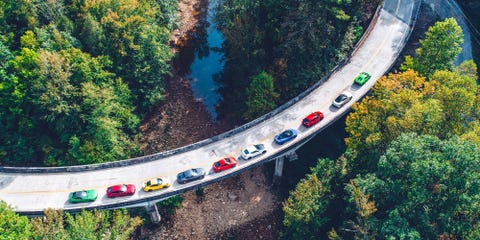
DW BURNETT
THE CONTENDERS
Welcome to the fifth year of PCOTY. As in the past, competitors must be new or significantly revised for 2017, and they must be series-production cars that push the limits of performance and pleasure on both road and track. That means no crossovers and no track-only specials. In all cases, we request the purest possible expression of enthusiasm in any given platform, which is why we have the Civic Type R instead of the outstanding Civic Si. It’s also why the Camaro on hand wears dive planes to complete its two high-performance badges—ZL1 and 1LE.
Although we invite every car that fits our criteria, some manufacturers are unable to meet our scheduling requirements, while others dislike the prospect of exposing their products to our unsupervised and unblinking evaluation. This year, we had 10 contenders answer the bell. The field was incredibly diverse, so we decided to start by giving each car a chance to compete directly with its closest neighbors, both in terms of intent and execution. Therefore, the contenders were divided into four brackets.
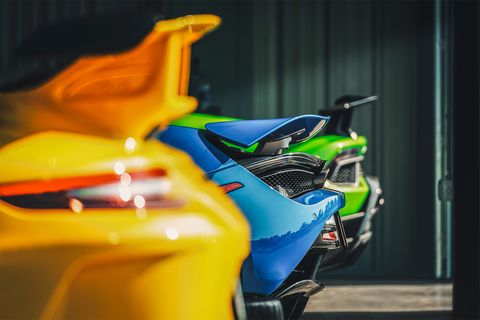
RICHARD PARDON
The Lamborghini Huracán Performante, fortified with additional power from its naturally (and defiantly) aspirated V-10 to complement what is arguably the most innovative active-aero package in production-car history, faces off against the captivating and enigmatic new McLaren 720S for our Supercars crown. In the Grand Tourers category, Bentley’s W-12 Continental Supersports will play the bespoke beast to the Lexus LC 500’s cyberpunk aristocrat. Porsche already won PCOTY with the 991-generation GT3 in 2015, but the cognoscenti-pleasing new option of a six-speed manual transmission makes it a natural fit for Track Stars competition, where it will reprise its Ring rivalry with the brutish Mercedes-AMG GT R and Chevrolet’s Amtrak-like ZL1 1LE. But first up, we have the Wild Cards: The Type R will play the plucky underdog in a cage match with Audi’s wicked-quick TT RS and Alfa Romeo’s unashamedly operatic Giulia Quadrifoglio.
After two days on the road and two days at NCM Motorsports Park, our jury of editors selected a winner for each category. A second round of voting chose the Performance Car of the Year from that final four. It’s not about raw lap times, and it’s not about racking up the high score on some kind of stat-sheet version of Space Invaders. The purpose of PCOTY is to find the car that advances the state of the performance art and sets a new standard for its peers. It could be a warp-speed two-ton hammer or a carbon-celled scalpel—but in the end, there can be only one.

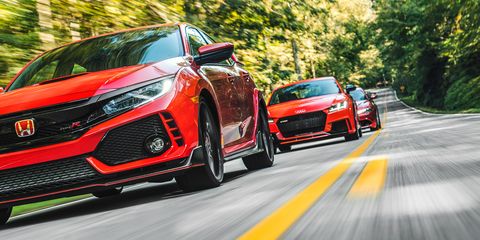
RICHARD PARDON
THE WILD CARDS
Alfa Romeo Giulia Quadrifoglio | Audi TT RS | Honda Civic Type R
This is an odd group. A Japanese hatchback. A German coupe. An Italian sport sedan. The only common thread is the rarity of the badging, how special each car seems. Honda’s giant red R was last sold in America 16 years ago, on the hyperfocused Acura Integra Type R. This country hasn’t had a new Alfa Romeo sport sedan since the 1990s, much less one with the legendary Quadrifoglio clover. Audi’s RS logo has a long and storied history, and most of that lineage never legally crossed the Atlantic.
It used to be that, while the rest of the world got Rs and RSs and four-door Alfas, we just got lust across oceans. Now we have a twin-turbocharged, rear-drive, 505-hp Alfa sedan with an exhaust that knocks birds out of trees. A 306-hp turbo Civic with obscenely large seat bolsters and a mammoth wing. And a five-cylinder Audi that spits out 400 hp and traction whenever you need it.
The Audi looks deeply German, reserved and serious, probably because it is. And the Alfa . . . well, it looks like an Alfa. Drive it through a city, and pedestrians literally fall off sidewalks angling for a look. (To the man who tripped into a rural-Tennessee crosswalk while gawping at the Giulia, as I made a left turn: I’m sorry I laughed. It was only because I once stumbled the same way, almost a year ago in Europe, the first time I saw the car.)
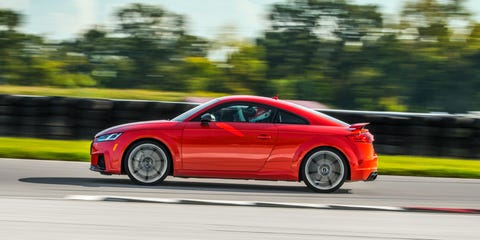
MATT TIERNEY
Somewhere near the Cumberland River, off a road that winds and churns, I fell into a groove with the Audi. Even next to the Civic, it feels a little ordinary—like other TT variants, the RS uses VW’s MQB platform, which also underpins the Volkswagen Atlas and seventh-generation Golf. But the car cracks through switchbacks and whoops without so much as a flinch. The steering is crystal clear and quick enough that you don’t so much guide the car down the road as nudge it through landscape. The suspension offers what feels like yards of travel and remarkable wheel control—more compliance than anything here, save the McLaren—and the twin-clutch gearbox is absurdly quick, one of the best in the world. Mile after mile, the Audi produces little fatigue or work for the driver, just relentless pace.
In this company, however, that’s not enough. The TT was the first of this trio to be knocked out, and no one was surprised. Partly because, while the RS is sports-car expensive, it still feels like the world’s best VW Golf.
“It’s a smart choice,” editor-in-chief Kim Wolfkill said, “but not especially stirring.” Website director Travis Okulski agreed: “Love the sound from the five-cylinder, but something is missing.” On the track, the 3270-pound TT works well—the car is remarkably quick, with strong brakes and a willingness to swing the back axle in a corner. But you never stop thinking about the raw vibe of old Audis. How those cars oozed aggression, not cold competence.
Contributing editor Chris Chilton summed it up. “For me, the best TTs are the cheapest: less grip, less weight, more fun. This is Porsche money, and at that price, it’s out of its depth.”
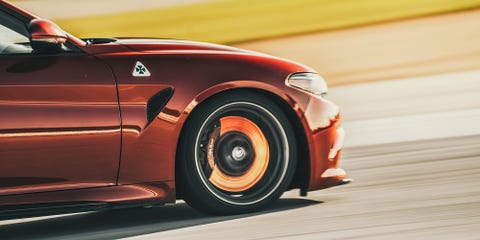
RICHARD PARDON
If the RS keeps you at arm’s length, the Alfa grabs you in a bear hug. The cannon-fire exhaust, the styling—it’s as enchanting as the Audi is dry and distant. Surprisingly, though, as we got deep into the backwoods of Tennessee, the Giulia’s fan club shrank. The test started with everyone in love. As the miles racked up, those feelings turned to weary resignation.
“No sedan tents your trousers like this,” Chilton noted, “but I was disappointed. The steering is too quick, too light, and has no feel—a nasty combo.”
He’s right; the Giulia’s ferocious steering rack and hypersensitive throttle sponge up your attention. Even a sneeze can throw the car off-course or unsettle it in a corner. The Quadrifoglio has so much tire and torque, with excellent damping, and it works so well when you’re cracking the whip, you want to love it. But then you let your guard down for half a second and things get sloppy. You can get unintentionally sideways or make a massive lane departure on a switchback, because you had a hand slip on the wheel. Or you induce a head-jerking stop from the touchy brake-by-wire pedal, because you decided to adjust the radio at the wrong moment.

RICHARD PARDON
“I admire Alfa for cooking up its own dynamic flavor,” deputy editor David Zenlea said. “We didn’t need another BMW imitator.” But toward the end of the first road-test day, even he wasn’t jumping at the keys. Over hundreds of miles of back roads, the Giulia wears on you. The trade-off, admittedly, is an intoxicating track experience: Greasy slides are forever a toe flex away, and the Alfa rewards like few others. When you nail a corner or a drift, the car seems to loosen up and grow more charming, as if to pat you on the back.
For better or worse, the sum experience recalls modern Ferraris. Fitting, given that the car’s development was led by an ex-Ferrari engineer. But also frustrating: That man’s previous project, the 458 Speciale, was an amazing car for the first 30 minutes and exhausting for every mile after—just like the Quadrifoglio. Shouldn’t a sport sedan work with you over distance?
That leaves the Civic. A machine many of us did not truly understand, or even like that much, at first. The bodywork seems not so much styled as vomited into place. That 7000-rpm turbo four is neither a joyous revver nor particularly charming in normal driving. “It’s more of a buzz than sonorous,” senior editor Matthew de Paula said, “and I miss that high-rpm VTEC fury.” Deputy online editor Bob Sorokanich stepped out of the Civic after a short back-road blast for photography reminiscing about the Hondas of his youth. “It didn’t have that same talkative front end and razor-sharp throttle.”

RICHARD PARDON
It’d be a lie to say that no one missed the old company vibe, the spirit of the Integra and the S2000. But good Lord, does the Type R hustle. And above all, it shares one thing with the cars of the old-school Big H: Calm and comfortable when you’re cruising, a firecracker when you lean into it. The taillights wag on trailed brake, and the Civic will launch over track curbs or road chuckholes with your foot to the floor, the helical limited-slip clawing away, the car not even remotely slowing down. Topping it all off, no Civic ever had a brake pedal this communicative or effective—the enormous Brembo calipers behind the front wheels virtually evaporate speed.
Alone in this group, the Honda begs you to get angry. But it’s also a fully finished piece, capable and resolved at once. “Magic,” Wolfkill said, “and the handling is standout.” Okulski was shocked: “No torque steer. How?”
You forgive the styling, that obnoxious wing, the gaudy interior. The Honda wants to be hammered on for days, and unlike with the Alfa or the Audi, you’re thrilled to comply. —Sam Smith
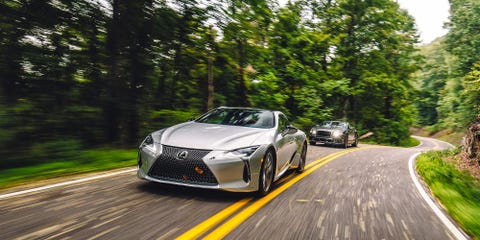
DW BURNETT
GRAND TOURERS
Bentley Continental Supersports | Lexus LC 500
These were the hardest cars to suss out at PCOTY. It’s easy to distill what we want from a McLaren (maniacal performance) or even a Civic Type R (maniacal performance, on a budget). But ask a bunch of car-magazine editors what makes the perfect performance grand tourer, and you’ll get a dozen conflicting answers. Congress has an easier time reaching consensus.
It didn’t help that our contenders are as far apart as the Sierra Club and the Koch brothers.
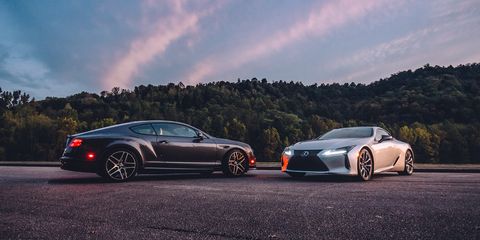
DW BURNETT
The Bentley: more than two and a half tons of opulence yanked along by 700 indefatigable horses. The result: otherworldly thrust. Slap the trucklike shifter into Sport and the W-12’s distant thrum moves one room closer as the mansion catapults, flattening your facial features. The big Brit outsprints nearly every other PCOTY competitor, from anywhere on its clock-dial tach. Snap your right foot back and the titanium exhaust pops and rattles extravagantly on deceleration, to help millionaires reminisce about badly tuned carburetors.
The experience is old-world, in part because this is actually an old car. The new Supersports spec adds 118 horses and brake-based torque vectoring, but the Continental hasn’t received a significant update since 2011, and the platform traces back to the original Volkswagen Phaeton. The interior reaches back in time, too. The infotainment system is tragically outdated; tech options you get in a Chevy are absent in this $327,985 beast. That said, most of the Bentley’s cabin is timeless. Buttery leather and sumptuous Alcantara line most touchable surfaces. Real metal—polished or knurled, cool to the touch—adorns every dial and knob, with Bentley’s delightfully dainty organ-stop vent controls sprouting from the checkered carbon-fiber trim. Our example’s black, white, and red interior had all the subtlety of a soccer-team uniform—“to the manner born, but it was a bad manner,” contributor Jack Baruth quipped. But sinking into the top-stitched driver’s seat and summoning the volcanic W-12, your concern for others’ opinions vanishes.

DW BURNETT
Conspicuously wealthy appointments, private-jet pace, a hushed but not silent engine always murmuring a tantalizing tale of torque. This is the Bentley approach to performance taken to extreme. Breezing down the highway, it’s a convincing approach. But on switchback country roads or the sinewy NCM circuit, the Bentley’s stately poise unravels. Effortless, unflappable ease boils over into a yard-long brake pedal, mushy steering, and speedboat body control.
“Pure, unadulterated, unrelenting acceleration,” Wolfkill said of the Bentley, “in a car that isn’t quite sure what to do once you’ve achieved terminal velocity.” Chilton was more blunt. “On the road at quickish pace, it’s kind of enjoyable,” he admitted. “But I hated it on track. Might as well have been driving an Escalade.”

DW BURNETT
Others found charm in the Bentley’s disdain for the eleventh tenth. “You feel important in the Continental,” Okulski said.
Editors consistently felt something else in the Lexus: stunned.
“Surprisingly light on its feet,” Wolfkill said of the Lexus. “It changes direction quickly and predictably—not what I was expecting.” Then there’s the noise. On our first morning of track testing, multiple editors scrambled to the pit wall to see which exotic was shouting Mustang rock ’n roll at the Kentucky sky. Imagine their befuddlement as they traced it back to the LC 500’s (decoy) chrome tailpipes.
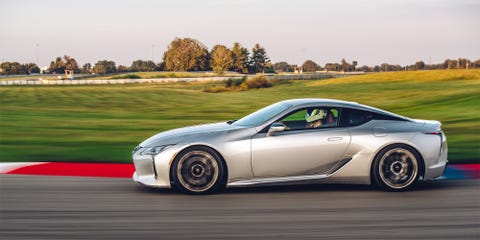
DW BURNETT
Physics explains a lot of the LC’s athleticism. The Lexus is nearly as long as the Continental but lighter by almost half a ton. Yet the differences between the two cars are even greater than the scales—or, for that matter, the $206,030 spread in base prices—indicate.
In its default Normal mode, the LC 500 continues the tradition of unobtrusive, easy driving that has long been a Lexus hallmark. But dial up Sport S+ on the drive-mode knob (one of two sticking out of the gauge binnacle like Frankenstein’s neck bolts) and this quiet cruiser jolts to life. The cushy suspension firms up; the steering, always sharp and direct, quickens noticeably. The 10-speed transmission whip-cracks itself through a fistful of downshifts, keeping the naturally aspirated 5.0-liter V-8 within eyeshot of its 7300-rpm redline at all times.
Some wondered if this frenetic alter ego fit the grand-touring vibe. “Do you want to have to rev a GT car to death to get that whoosh of forward momentum?” asked Okulski. Others argued a performance grand tourer should be able to find another metaphorical gear. “It’s about looking pretty, feeling comfortable—and being able to kick ass when occasion calls for it,” Zenlea said.
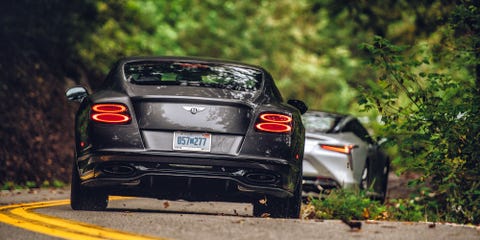
DW BURNETT
Where the Bentley’s interior evokes old-English charm, the LC 500’s presents a stylish, daring vision of the near future. Someone likened the dashboard to midcentury-modern stereo equipment, a low, wide, horizontal motif flanked by dramatic sweeping curves. The infotainment system, meanwhile, looks newer than the Bentley’s but is somehow even more frustrating. Editors called the LC 500’s infuriating touchpad interface “janky,” “dreaded,” “a nightmare,” and “impossible to use.” Over two days of lapping at NCM, the GPS insisted we veer off track and cut a path to the nearest highway. Nobody could figure out how to deactivate it, so we drowned it out with V-8 music.
Voting hour was contentious. Traditionalists raised their hands in favor of the Bentley’s stodgy charm. “It does everything in the proper Bentley way—big, luxurious cruising,” Baruth argued. “They finally made it feel British, special.” Yet the majority—just barely, with design director Matt Tierney pulled in as a tiebreaker—thought the Lexus offered the R&T definition of a GT: a stylish cruiser that can still clip an apex and be steered with the throttle. Consensus may be elusive, but through the messy democracy of PCOTY, the Lexus is the winning candidate.—Bob Sorokanich
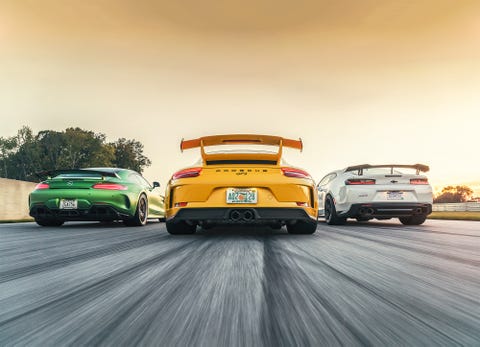
RICHARD PARDON
TRACK STARS
Chevrolet Camaro ZL1 1LE | Mercedes-AMG GT R | Porsche 911 GT3
The first line in the 911 GT3’s Driver Logbook sums up the childlike excitement this group of cars engendered. “The engine at 9K! The engine at 9K! The engine at 9K!”
Sports cars honed for track driving are like divers’ watches: They look pretty, cost plenty, and are massively overengineered for the use they’re going to get. Driving them on the street is mostly about the great feeling of having all that potential right at hand, being the big dog in any pack. Despite their stiff legs, serious-looking aero mods, and “is it street legal?” rubber, you could use any of these cars as a daily driver—with a few caveats. They’re carpeted, soundproofed, and air-conditioned. “Get in, and if you’ve driven any other Benz, you know how to operate the AMG GT R’s various controls,” Wolfkill said of the big, green monster. “The switchgear is familiar, the environment strangely comforting.”
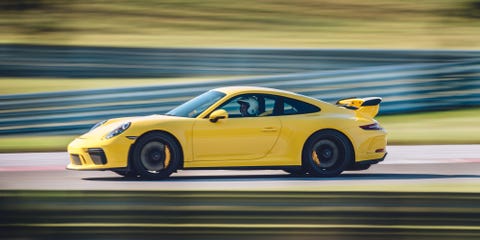
DW BURNETT
Even the Racing yellow 911, in spite of carbon-fiber bucket seats that defied adjustment, was a darling to drive through backwater towns, thanks in part to its panoramic views and perfectly weighted clutch pedal. The Camaro was no less accommodating. “I only ever drove it on dry, mostly smooth pavement, but this thing felt more sure-footed and comfortable than any track-day special has a right to,” Sorokanich said. These cars were practical in unforeseen ways, as well. Those massive rear wings that create such stability at speed made a sturdy map table when planning our next leg outside Bubba’s BBQ and Grill, in Grimsley, Tennessee. Point is, they might look like race cars—and in some cases they’re even faster than the race cars on which they’re loosely based—but they don’t demand special skills to be driven briskly.
Still, there are compromises. Starting with ride quality on anything other than billet-smooth asphalt. The fat 305-section front boots that come with the ZL1’s 1LE package are so easily distracted that holding the steering wheel can feel like walking a pair of police sniffer dogs through a network of crack dens. At least the 1LE’s ride is a huge improvement over the last-generation Z/28’s. Meanwhile, the wide AMG GT R is twitchy, too, with its stiff damping and fast steering rack. To get the best out of it, you must constantly monitor your inputs.
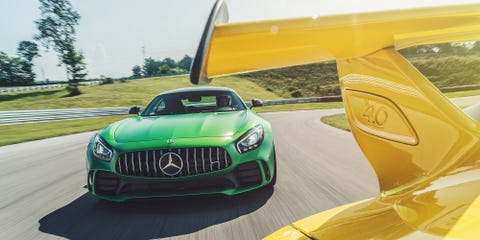
RICHARD PARDON
That’s also the mind-set you need when approaching the Porsche, with its screaming flat-six that proves both a blessing and a curse. When can you realistically rev it to redline on the street, when 9000 rpm in second gear is good for 83 mph?
At least this GT3 is easier to tool around in than its predecessor, as the engine has been stroked, from 3.8 to 4.0 liters. There’s more torque down low, so you don’t have to rev to redline for scorching acceleration.
The Porsche nevertheless feels slower than the Camaro and GT R, both of which pair honking V-8s with forced induction. Driving the GT3 on the street is ultimately about the melodrama: a high-rpm shriek that could shame an F1 car, and throttle response so sharp, it could snap you in two. “It just hits that car-enthusiast sweet spot,” de Paula noted.
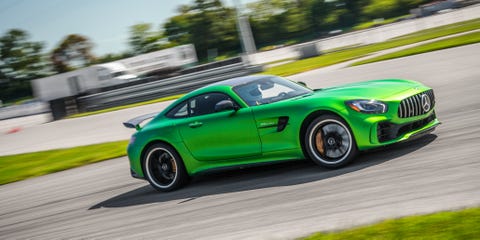
MATT TIERNEY
Of course, track cars are ultimately about the track. Back-of-an-SCCA-license-form calculations and familiarity with the 911 suggested the Porsche, the lightest car of the three, might keep the more powerful GT R honest at the NCM circuit, where the steering wheel is almost never straight. Wrong. The AMG was outrageously rapid, more than four seconds faster than the GT3. The GT R reminded us of the Viper ACR we had here two years ago in its rock-solid stability through NCM’s fast Turn 5, its outright grip on a sticky set of tires, and its composure under braking.
At least those are the subjective impressions of where the AMG saved time. When we started dissecting the VBOX data, it turns out that the Mercedes was indeed faster in those spots—but also everywhere else. The GT R hit the highest speeds on the straights, braked later, and carried more speed through the turns. Getting out of those turns was made easy, thanks to that yellow, knurled traction-control dial on the console. With the nine-position knob set dead-center, one can stand on the GT R’s right pedal as soon as the corner opens up.
For those chasing that last hundredth of a second—and there were a few at PCOTY—the GT R is the perfect tool. And that’s exactly what it feels like: a tool—a ruthless, brutally efficient device for systematically tearing apart lap times.

RICHARD PARDON
But fastest doesn’t always equate to most fun. The slower 911’s signature handling, the way it demands you keep that light front end happy before turning your attention to the rear, offers more of a challenge. As does its manual transmission. The three-pedal setup is back by popular demand after a four-year sabbatical. But over four days of testing, there were as many voices admitting they’d rather have a PDK as there were rhapsodizing about the interactive delights of the stick’s sublime action. “Shifting the manual gearbox interrupts the glorious revving for just a touch too long,” Wolfkill said.
Editor-at-large Sam Smith, who’s driven both manual and PDK variants, pointed out another difference beyond the tactility of the manual shifter: packaging limitations mean stick-shift GT3s can’t be fitted with the PDK’s torque-vectoring differential.
“Without that diff, you have to work harder to turn the car,” Smith said. “It feels more like a classic 911.”
That kind of dynamic might be great for true 911 buffs, but it also might be one reason why, of this trio, the Camaro spent the least amount of time idling on pit lane. Everyone queued up to drive it, hammering the Brembo brakes that make light of the 3842-pound heavyweight, leaning on those colossal tires and throwing gears at the 650-hp V-8 via a shifter that’s lighter and slicker than expected, given what it’s bolted to. “You could remove every other gear in this car’s transmission and just drive everywhere in third, with no appreciable impact on fun,” Sorokanich said.
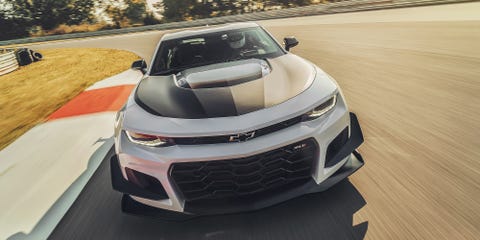
RICHARD PARDON
The ZL1 just sucked it up, lap after lap, like the Labrador that keeps chasing a stick for as long as you’re willing to throw it. It’s one of those great cars that demand little from a driver but reward anyway. Those with less experience on the NCM track never felt intimidated, and those with bulging notebooks testifying to seat time in similar cars felt like they were really getting under its skin.
And, of course, it is fast. The Camaro clocked a lap time of 1:32.15, beating the 911 by 24 hundredths. And did we mention the price? We try not to in this competition. But when a machine costs half as much as a 911 GT3 and is faster around a racetrack, while plastering a grin across the face of everyone who drives it, the fact that said car is such a bargain makes it even more noteworthy.
All in, the GT R’s impressive lap time showcases what an incredible job AMG has done turning the so-so GT into a proper driver’s car, and the 911 is as nuanced as it ever was. But the egalitarian ZL1 1LE won us over. Underdog, you say? Überdog, is more like.—Chris Chilton
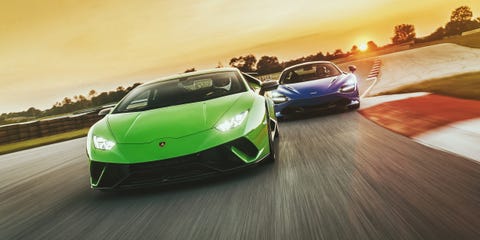
RICHARD PARDON
SUPERCARS
Lamborghini Huracán Performante | McLaren 720S
Two supercars, each alike in dignity—except that is far from the case. Not quite chalk and cheese, what we have here is swagger and sleek.
First, the Huracán, running foot to the floor through fourth gear in Strada (street) mode, surprising the wildlife on the far side of the tarmac, appearing from nowhere with shark-shaped, nose-down, wings-and-spoilers greenburst. Only when it’s almost gone do you hear the 8500-rpm roar blasting from heat-blued pipes in the Kamm-cut, Reventón-style tail section. All green up front, all black in back, with aero add-ons ahead, around, and behind, crafted from this improbable-looking, milky-textured carbon composite that also pervades the interior.
There are moments when you catch the car in repose, perhaps trailing it on the freeway during the transit sections that connect our back-road runs, and from the rear three-quarter angle, it fairly screams: “Jalpa!” Something about the combination of the big, blind sail panels and set-in doors. It’s the junior Lamborghini, and you can trace its heritage back 40 years. But don’t be fooled. The rest of the car is Essence of Diablo, refined and concentrated and bottled neatly in the unashamed retro wedge shape and the naked aggression of the Performante upgrades.

DW BURNETT
The competition has all eaten of the forced-induction apple, but Lamborghini remains serenely in paradise with its 5.2-liter naturally aspirated V-10, now pushing 630 hp through an all-wheel-drive system that makes less use of the front axle than the rear. The power is omnipresent, undeniable, seamless. Flick the column-mounted paddles down once or twice and objects in the trapezoidal flat windshield are suddenly closer than they appeared. “Feels like sitting inside Bertone’s doorstop,” said road test editor Kyle Kinard, and he’s right.
No matter where we went, the Performante was the unchallenged star of the show. The McLaren 720S might have those fabulous dihedral doors, but to the man on the street who doesn't know what it is, the car still has that faint fiberglass whiff of kit car to it, as if there just might be an old Volks-wagen Beetle lurking under there somewhere. By contrast, the Huracán has unchallenged provenance, an aristocracy of sorts where the family portraits aren’t oil paintings in the main hall, but rather glossy posters on the wall of every teenaged boy’s room since 1979. It traces its lineage directly back to the Miura and requires no explanation whatsoever.
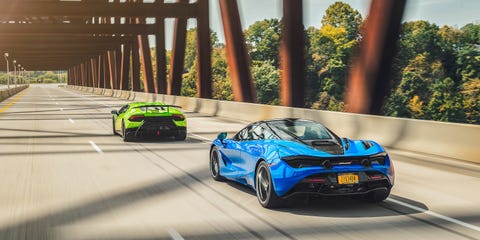
RICHARD PARDON
Okulski was moved to superlatives. “The first ‘complete’ car Lamborghini has ever built. There isn’t a glaring flaw, it’s just brilliant and special through and through. The best Huracán—and best Lamborghini—ever.” That word, “complete,” came up again and again in the discussions that peppered our driver changes. You can let it idle for half an hour in a parking lot on a 95-degree day and it won’t complain. The Huracán’s Gallardo predecessor claimed to be an “everyday supercar,” but some of us felt that Lamborghini went light on the “supercar” part in order to make the “everyday” side work. No such compromise here.
Up gnarled hillside roads, the Performante could reel in the others at will. It might not have the most power in our group, but it delivers immediately, sans turbo lag or a time-consuming shift. You sit right up front, just three feet from the wheels that steer, and it sometimes feels like you can see around the turn.

RICHARD PARDON
Without peer in the realm of conventional supercars, the Performante should be a lock for the win here. There’s just one problem: The McLaren 720S is utterly unconventional. You can feel it the moment you settle into the embrace of the close-coupled seats, which sit 15 inches inboard of the door skins and leave just enough room for the Lord between them. The Huracán might as well be an F-150 by comparison; it comes from the old school, where Countach owners expected to be separated from their passenger by a foot’s worth of lightly wrinkled leather paneling.
The 720S has controls scattered hither and yon, tucked into such furrows and recesses as McLaren could carve out of the cockpit. There’s a bit of style that was lacking in the previous-generation 650S, yet the cabin’s main attraction is its minimalism, which makes it seem roomier and ultimately more comfortable. “I especially appreciate the amount of light it lets in,” said Wolfkill. “So different from the typically cramped and dark supercar cabin.”

DW BURNETT
This is a machine with performance to raise the dead. It takes a bit of poking and prodding to activate the secondary settings for engine response, active aero, and suspension control, but no matter which way you shuffle that deck, you will be humbled by the power on hand. The McLaren leaps to 150 mph from a crawl. In lower gears, you might not be able to click the wheel-mounted paddle on the right quickly enough to keep up with the manic 4.0-liter V-8 as it turbo-whistles across the tach.
On the boil, nothing short of a Kawasaki ZX-10RR has a prayer of keeping up with the McLaren. Maybe the hybrid hypercars, if their batteries were full. And when the first curve comes, you dial in the perfect amount of steering as if you’ve studied the car your whole life, and that’s when nothing can touch it. A 710-hp, rear-drive supercar could be forgiven for being difficult. This one isn't. The 720S will educate you, teach you what it needs with subtle touches of feedback in the steering and brake pedal. The car feels so natural, just like an old Formula Ford that happens to have acquired a commercial jetliner engine. “It’s an obviously digital thing, but it feels analog. And it succeeds masterfully. This is the future of sports cars and supercars,” Okulski noted.
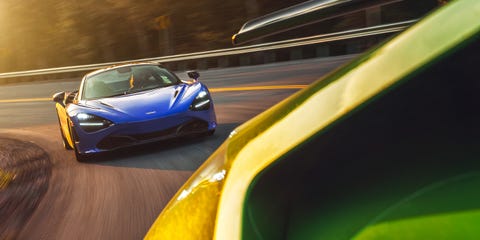
RICHARD PARDON
If the Lamborghini is pure theater, the McLaren is pure purpose. The 650S and sublime 675LT were a little light on rear visibility, so now the 720S has see-through rear roof pillars. The headlights are strong enough to expunge the mystery from a triple-digit nighttime blast. Finally, there’s the ride, which is a magic carpet courtesy of the second-generation hydraulic suspension. The Lamborghini can rattle your teeth on rough pavement; the 720S won’t even spill your soda.
Sorokanich spoke for the group when he called the McLaren “the friendliest, least intimidating supercar I’ve ever experienced.” This pussycat is more than what’s new in supercars; it is also what’s best, what’s fastest, what’s most capable. As such, the 720S was the easy winner of our vote, with only your humble author and a few other Countach-poster holdouts in sullen dissent. Wolfkill doubled down: “If the Huracán represents the ultimate evolution of the old-school supercar, then the McLaren is the embodiment of the new-school approach.”—Jack Baruth
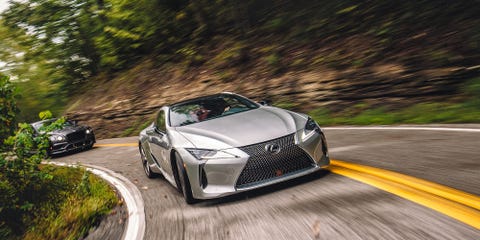
DW BURNETT
THE FINALISTS
And then there were four—the Chevrolet Camaro ZL1 1LE, Honda Civic Type R, Lexus LC 500, and McLaren 720S. You’d be hard-pressed to choose a broader-spectrum anti-biotic for creeping automotive disinterest, yet at the core, each of these cars expresses a similarly uncompromising approach to performance-focused engineering. They’re loaded with things that you only notice after long examination: the heavy-duty steering knuckles on the Civic, the combination knob/switch used by the Lexus to adjust the shocks and relax the stability control, the knee bolstering on the Camaro’s center console, the way the TFT dashboard on the McLaren Fosbury-flops out of the way for unimpeded vision on a racetrack. You can have opinions about the Civic’s aero package or the McLaren’s socketed headlamps, but you can’t say that our final four don’t bring their A game in nearly every aspect that matters to a driver.
In years past, the PCOTY voting process has taken as long as four hours, often laced with impassioned speeches, tense disagreements, and uncomfortable bouts of soul-searching. Not this time. A single round of discussion and voting took a fraction of that. Our eight editors each assigned a ranking to the finalists. The rankings were added and averaged to provide the final results. Only two cars received first-place votes, and the mathematical distance between each place turned out to be unequivocal.
In fourth position we have the Lexus LC 500. “Never felt wallowy, oversized, or heavy, either on street or track,” noted Sorokanich. This unabashedly design-centric exercise in prestige-coupe production should have been out of its league among the hard-edged, apex-focused competition. The fact that it held its own on track and in fast driving, bellowing a Talladega battle cry through its ornamental exhaust and cranking into every corner with a Supra’s worth of tail-out attitude was more than enough to earn our admiration. Yet this is a platform that fairly cries out for the full F-for-Fuji treatment. If the powers that be at Lexus think the brand can stretch to accommodate a fiercer and faster variant of the LC, we’d be delighted to give it another shot at the title.
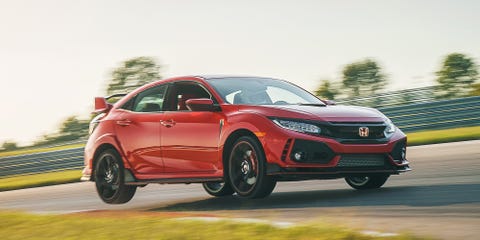
RICHARD PARDON
The third spot goes to the Civic Type R. Let’s get the low points out of the way in a hurry: The engine rarely feels fast and never comes across as particularly furious, the steering can seem inert, and the visual package is, shall we say, controversial. Chilton was properly cutting: “Even if it was quicker than the AMG, I couldn’t forgive those fake bumper grilles.”
None of those problems will stop the Type R from sporting additional-dealer-markup stickers for some time to come, however, because this is a Honda truly worthy of the coveted red badge.
In a market segment where some competitors are gelded by crossover-grade all-wheel drive and a ’77 Cutlass Supreme’s worth of curb weight, the Civic shines despite, and by virtue of, its fealty to the original hot-hatch template. “It possesses the unique ability to be driven like a front-wheel-drive car when it’s convenient—back it into turns under trail braking to get it rotated—without suffering from typical front-drive hang-ups under acceleration,” said Wolfkill. And the almost cosplay-like dedication to Nineties Ginza chic, while not everyone’s taste, will create a lot of fanatics and inspire plenty of tattoos. Most important, it’s a reminder that Honda still cares about its enthusiast owners.
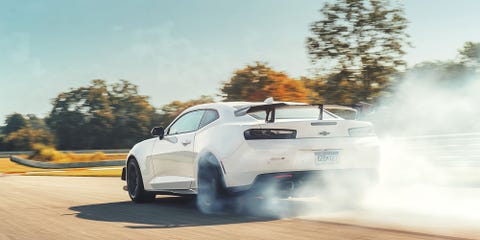
RICHARD PARDON
Two editors cast first-place votes for the Camaro ZL1 1LE, and no wonder. The big-box Chevrolet seems to vibrate from the tires up with a sort of manic pixie dream pony-car joyfulness. “Still big and heavy, but that makes it all the more impressive,” Okulski said. “The only limiting factor on track time is the amount of fuel in the tank—it could run for days straight.” If the C7 Corvette Z06 is a very good car, and the previous-generation Camaro Z/28 was a flat-out great car, then this combination is somehow even better than the sum of its impressive parts. Capable of running with $200,000 supercars, yet easily serviceable at your local GM dealer, the ZL1 1LE is a stunning statement of intent and an example of what America’s biggest car company can do when it lets engineers turn their dreams into reality. God bless it for existing.
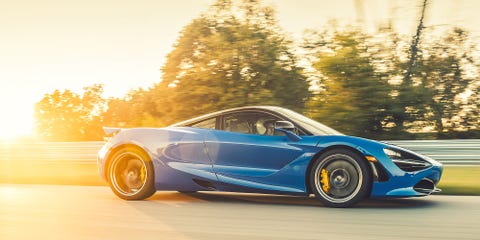
RICHARD PARDON
2018 Performance Car of The Year: McLaren 720S
Those of us who have been fortunate enough to drive McLaren’s exemplary 650S and utterly indomitable 675LT approached the McLaren 720S with no small amount of trepidation. There didn’t seem to be anything that needed fixing in the previous generation of the Super Series cars, particularly with regard to the longtail variant. In one respect, we were right to be worried. The 720S makes no pretensions to the rough-hewn rattle-and-clank Le Mans–series histrionics of the 675LT, and it can’t quite match that car’s concert-master touch on a road course.

DW BURNETT
Not to worry. There is surely an uninsulated track-oriented variant on the way. In the meantime, the new McLaren effortlessly earns the PCOTY laurels by performing the near-impossible: It rides better than the Bentley, outhandles the aero-intensive Huracán, and leaves the snorting Camaro dead to rights in a drag race, all while making its driver feel like the most special person in the world. You could own this car for a lifetime and never grow tired of the pur sang manner in which it conquers everything from a 200-mph blitz to the commuting crawl. No street car in history has offered a better driving position, a more immediate command of the road, or a better integration of usability and capability. And, not for nothing, it’s improved in every possible respect from the 650S, which was already one of the world’s most competent supercars.
In this fearsomely strong field of 10 brilliant automobiles, only this one truly advances the state of the art. The fact that it does so in the exospheric environment of the super-cum-hypercar only serves to underline the degree of difficulty involved. Inhumanly sleek, monstrously quick, reassuringly approachable, the McLaren 720S is our 2018 Performance Car of the Year.



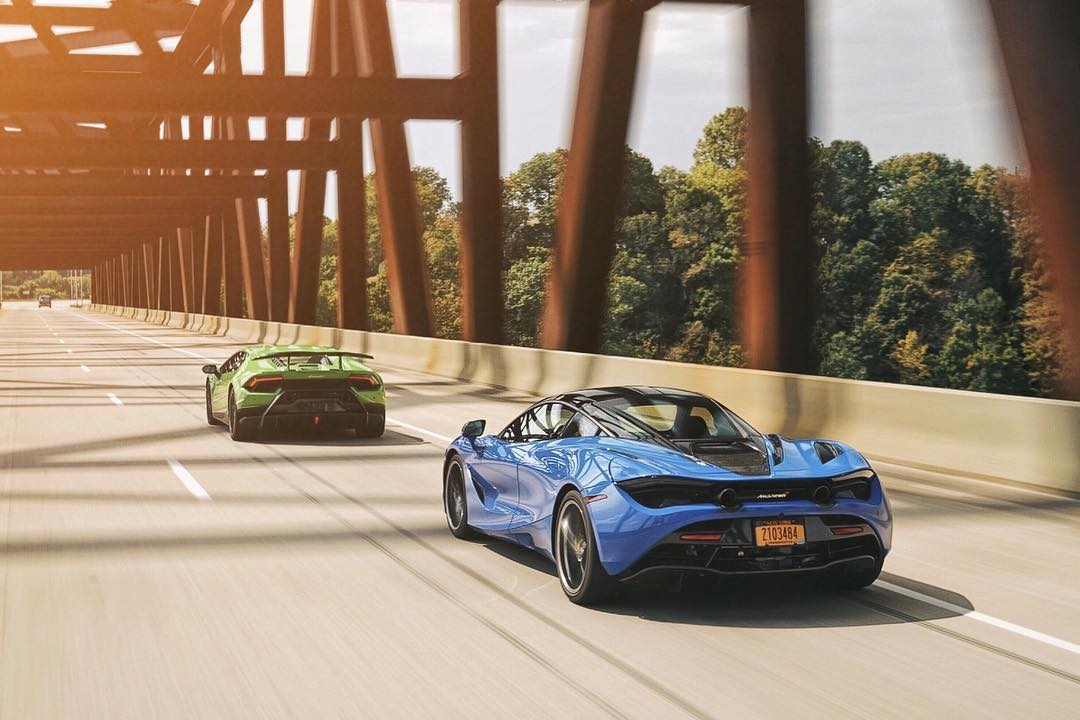







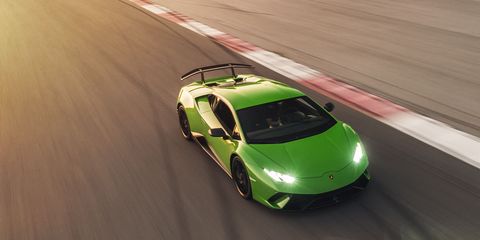
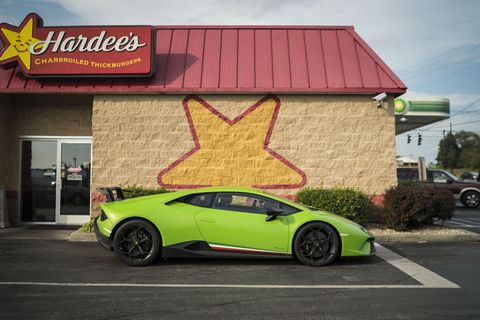
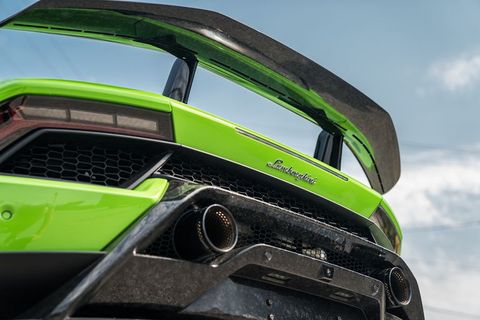
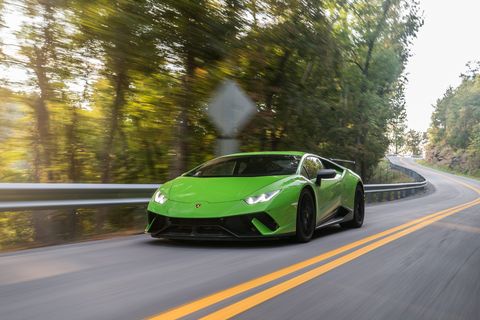
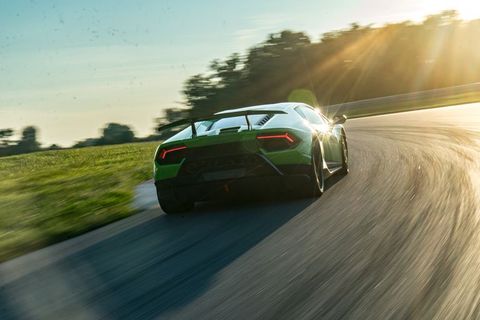









































 . However, you guys really need to open your minds. I have no doubt that the 720S is the best all round package in its class right now. That class has nothing to do with the 918 though. McLaren deserve a lot of credit for what they have pulled off in such a short space of time.
. However, you guys really need to open your minds. I have no doubt that the 720S is the best all round package in its class right now. That class has nothing to do with the 918 though. McLaren deserve a lot of credit for what they have pulled off in such a short space of time.
